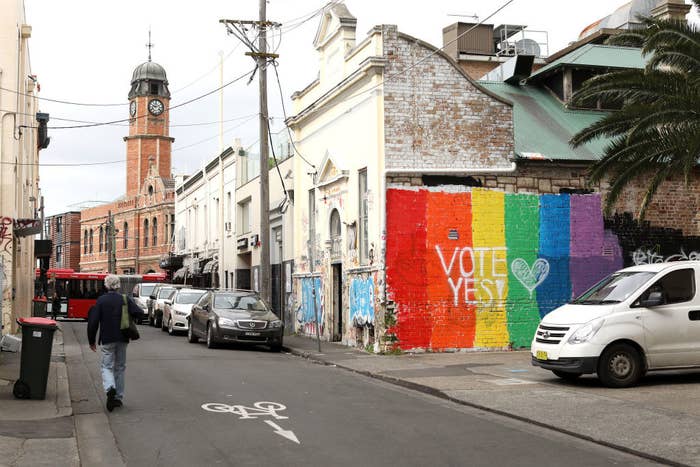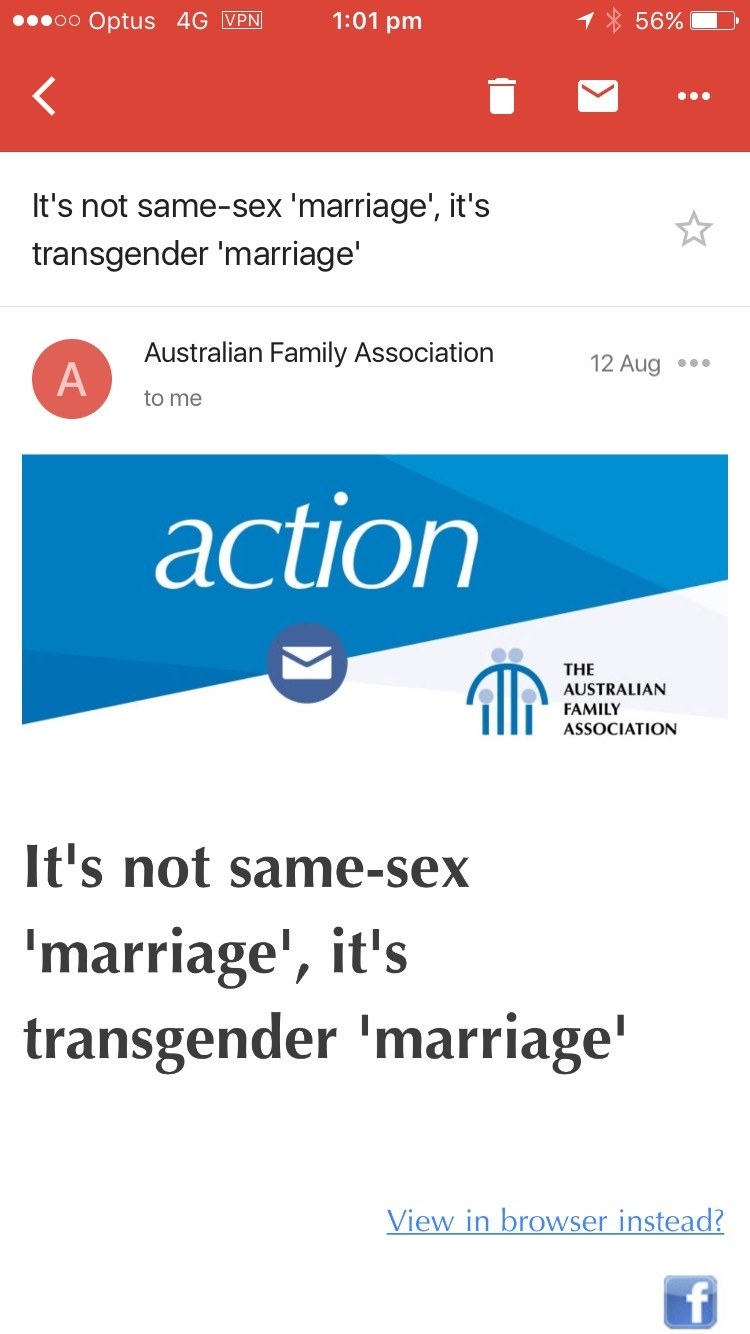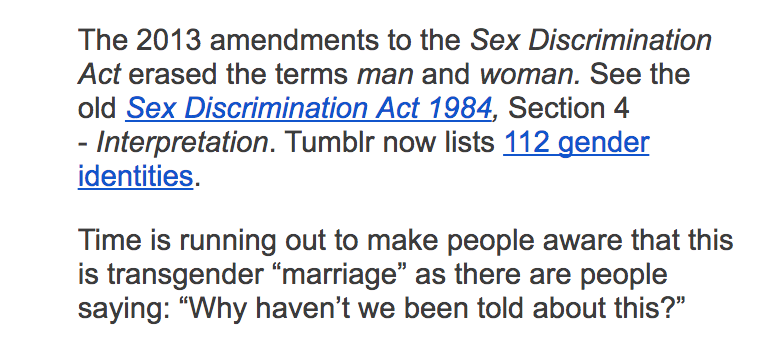
As Australia carries out its postal survey on same-sex marriage, the spectre of "transgender marriage" has been raised by some anti-LGBTI groups, as well as former Labor leader Mark Latham.
The Australian Family Association and the National Civic Council, which are very much opposed to same-sex marriage, have warned against allowing any two consenting adults to marry, claiming it will lead to changes in other laws.
Meanwhile, Latham wrote an opinion piece in The Daily Telegraph on Tuesday saying he supports marriage for straight and gay couples, but will vote "no" in a survey that would allow it for everyone.
So, will a "yes" vote in the postal survey allow all Australian couples to marry, or not? Here's some information:
The question you'll tick "yes" or "no" to in the postal survey later this year is: "Should the law be changed to allow same-sex couples to marry?"
But a "yes" vote won't automatically change the law — the parliament still needs to pass a bill to legalise same-sex marriage. And it's the wording of this bill that will determine who can and can't marry in Australia, not the postal survey itself.
On ABC TV's Q&A on Monday night, attorney-general George Brandis said there were several possible models for that bill — the "most high profile" being senator Dean Smith's, released ahead of the Liberal party room meeting that brought us the postal survey earlier this month.
Smith's bill, and the one released by Brandis in conjunction with the plebiscite legislation last year, both propose changing the Marriage Act in the same way: replacing the words "a man and a woman" with "two people".

This would change the definition of marriage in the act to: "Marriage means the union of two people to the exclusion of all others, voluntarily entered into for life".
This would mean any two consenting adults in Australia would have the right to marry. It might be a straight man and woman; a bisexual woman and a lesbian woman; two gay men; a transgender woman and a straight man; a non-binary person and a lesbian woman. And so on.
And while it's not guaranteed that any legislation passed by the parliament in the event of a "yes" vote will be worded in the exact same way, it is fairly likely that the "two people" approach will prevail.
Why? Because every bill put to the parliament in the past 10 years has taken this approach, plus earlier this year a bipartisan Senate committee found it was the most appropriate wording.
So, that's what we know so far. The rest is up to the parliament, in the event of a "yes" vote.
But some groups already in opposition to same-sex marriage have wielded the notion of "transgender marriage" as a tool in the debate.
A few days after the postal survey was announced earlier this month, the Australian Family Association sent out an email to supporters titled, "It's not same-sex marriage, it's transgender marriage".

The email makes the case that the "two people" change to the Marriage Act is not "same-sex marriage", but "transgender marriage".
According to the AFA, amending the Marriage Act to read "two people" would mean transgender sex and relationships education would be enforced in Australian schools. (There is no legal basis for this claim.)
It also claims that the "two people" change would mean transgender women can legally access "female school showers, change rooms and toilets, compete in women's sports and access female shelters". (These issues are dictated by anti-discrimination law or local laws and regulations, and are unrelated to any proposed change to the Marriage Act.)
President of the National Civic Council Peter Westmore also penned a piece warning against "transgender marriage" in News Weekly.
The AFA often sends out talking points to supporters, including an email last year that instructed supporters to tell their family and friends that being transgender is like having an eating disorder.
The email also referenced a list of gender identities on blogging site Tumblr.

In an email five days after the "It's not same-sex marriage, it's transgender marriage" email, the AFA tempered its language, saying it "could" lead to those things.
But it didn't let the argument go. On August 24, yet another email suggested supporters contact a list of businesses, including Qantas, McDonald's and Kmart, about "transgender marriage".
The letter template is as follows:
Dear [name],
Why is [your company] campaigning for transgender marriage? This will mean boys identifying as girls using the girls’ showers, change rooms and toilets, as advocated by the NSW, SA and Victorian education departments and the radical "Safe Schools" Coalition transgender sex education program.
The federal Attorney General’s Department said this year that making ‘2 people’ eligible to marry will allow people who are “non binary” to marry, i.e. a pangender can marry a gender queer person, or a man socially identifying as a woman can marry a biological woman and be in a lesbian marriage. (pg 2, Submission, no. 78 to the Senate Select Committee on the Exposure Draft of the Marriage Amendment (Same-Sex Marriage) Bill.)
If transgender marriage based on self-defined gender identity and sexual orientation is legalised, won’t it be an offence under federal Sex Discrimination Act 1984 for teachers to treat transgender marriages “less favourably” than same-sex and heterosexual marriages? And an offence for teachers to not tell children they can change their gender identity, and for teachers to refuse boys identifying as girls’ access to the girls’ showers, change rooms, toilets and sports?Why are you backing transgender marriage?
From [name]
None of the 21 companies targeted by the AFA have announced a retraction of their support for same-sex marriage since the email campaign began.
Many transgender, intersex and non-binary people in relationships can already marry, depending on their personal legal status when it comes to sex and gender.
For instance, Greens senator Janet Rice is legally married to her wife, Penny Whetton, who is transgender. Whetton's birth certificate still reads that she is male, and under current Victorian law, she and Rice would have to get divorced before it could be changed to read female.
While intersex people by definition have atypical sex characteristics, they do not necessarily exist outside of the male/female binary. According to a 2015 survey on Australian intersex people, 75% are male or female, while the remaining 25% have diverse gender or sex identities.

